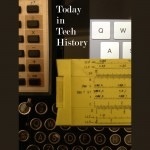 In 1879 – Thomas Edison finished up 14 months of testing with an incandescent electric light bulb that lasted 13½ hours. It improved on 50-year-old technology to make light bulbs safe and economical by using lower electricity, a carbon filament and an improved vacuum.
In 1879 – Thomas Edison finished up 14 months of testing with an incandescent electric light bulb that lasted 13½ hours. It improved on 50-year-old technology to make light bulbs safe and economical by using lower electricity, a carbon filament and an improved vacuum.
In 1949 – An Wang filed a patent for a magnetic ferrite core memory, that he called pulse transfer controlling devices. Two years later he formed Wang computers.
In 1983 – The seventeenth General Conference on Weights and Measures ruled the meter would be defined as the distance light travels in a vacuum in 1/299,792,458 of a second. This actually simplified it from the previous definition of 1,650,763.73 wavelengths of the orange-red emission line in the electromagnetic spectrum of the krypton-86 atom in a vacuum.
Subscribe to the podcast. Like Tech History? Get Tom Merritt’s Chronology of Tech History at Merritt’s Books site.